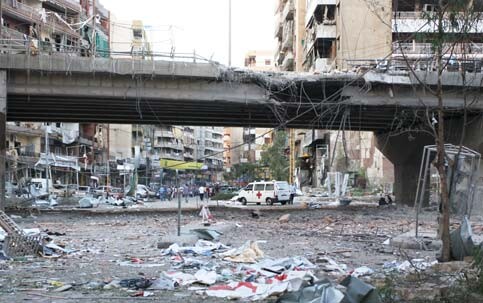Human Rights Watch 16 July 2006

The Bir el-Abed area in a southern Beirut suburb bore the brunt of an Israeli air strike, July 16, 2006. (IRINNews/Leila Hatoum)
17 July 2006 – The Israel Defense Forces should provide details about a bombing on Saturday that killed 16 people in a convoy of civilians fleeing a Lebanese village near Israel’s border, Human Rights Watch said today. Under international humanitarian law, all parties to an armed conflict must take all feasible precautions to protect civilians fleeing areas at risk.
On Saturday, a number of families fled the southern Lebanese village of Marwahin after the Israel Defense Forces (IDF) warned them to evacuate ahead of a threatened attack. On the road leading to the coast through Chamaa, however, Israeli missiles struck a convoy of the civilians. Maps of southern Lebanon show this road to be the only direct route for escaping the dangerous border area.
“The IDF needs to investigate this attack on a civilian convoy and provide more details about the circumstances,” said Sarah Leah Whitson, Middle East director at Human Rights Watch. “Having warned civilians to evacuate their village, Israeli forces should have been aware that civilians would be using this road and should have taken great care to avoid harming them.”
In an official statement on the incident, the Israeli military said that “Israel Air Force targeted an area near the city of Tyre, in southern Lebanon, used as launching grounds for missiles fired by Hezbollah terror organization at Israel. The IDF regrets civilian casualties while targeting the missile launching area.”
A photographer for an international news agency who arrived at the scene two hours after the attack told Human Rights Watch that he saw a white van and a passenger car completely destroyed. He counted 16 dead bodies. This account was confirmed to Human Rights Watch by UNIFIL (the U.N. peacekeeping force in southern Lebanon), which had dispatched a vehicle to the scene to recover the bodies and transport them to the city of Tyre. Subsequent news reports placed the number of dead at 20, including 9 children.
The photojournalist indicated that he saw two craters where the Israeli rockets had hit, one very close to the van and another approximately 100 meters away. He was not able to identify the type of rocket used in the attack. UNIFIL did not provide any details about the rockets, as a spokesman for the mission indicated that they do not have an observation post in the vicinity. Journalists posted in southern Lebanon later reported that the attack appeared to be the result of rockets fired from helicopters.
Eyewitnesses told Human Rights Watch that some of the bodies were completely burned and others cut-up, which was corroborated by photos of the scene. Most of the bodies were clustered around the van. The photojournalist interviewed by Human Rights Watch said he saw the body of one girl 20 meters away from the van and the bodies of one man and a child 100 meters away, close to where the second crater fell. He indicated that he did not see any armed person among the bodies.
At 9 a.m. on Saturday, approximately 100 residents from the village sought refuge and humanitarian assistance at a U.N. peacekeepers position situated 1.5 kilometers from the village. The residents informed the U.N. peacekeepers that the IDF had ordered them to leave the village and that they had no means to escape besides fleeing on foot. According to a UNIFIL spokesperson, peacekeeping officers contacted their liaison officers at the IDF and the Lebanese army and did not receive confirmation of the evacuation order. Accordingly, the peacekeepers told the villagers to return to their village with the belief that this might be safer for them.
At 11 a.m., a group from the village of Marwahin left the town in the convoy that was subsequently hit. UNIFIL told Human Rights Watch that the individuals in the convoy were not part of the group of 100 villagers who had sought refuge at UNIFIL’s post because that group did not have vehicles to leave the village.
“The U.N. peacekeepers should not turn back a vulnerable group of people seeking shelter from imminent attack,” Whitson added. “The United Nations needs to make an official review of the decisions that led to this event. This is critical to prevent a repeat of such an incident.”
In light of the physical isolation of Lebanese villages in southern Lebanon and the lack of means of transportation for many of these villagers, Human Rights Watch urges UNIFIL to provide shelter to civilians fleeing attack.
Based on information provided by relatives, news sources identified the victims of the attack on the convoy as:
- `Ali Kamil Abdullah and his son `Ali, Sana’ Muhammad Abdullah, Subha Abdullah and the children: Hadi Muhammad Abdullah, Rym Ibrahim Abdullah, Kamil Abdullah, Hassan Kamil Abdullah, Muhammad Kamil Abdullah, Hussain Kamil Abdullah, Zahra Faris Abdullah
- Muhammad Musa Ghannam, his wife Suha, and their children: Qassim, Mustapha, Hussain, Zaynab, Da`a’, Amina `Ali Ghannam.
Related Links